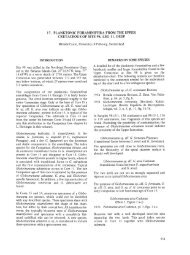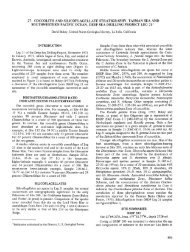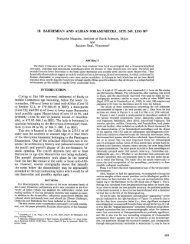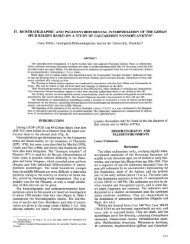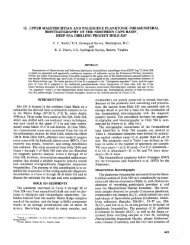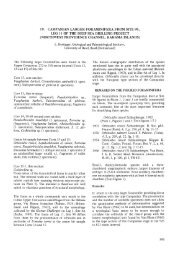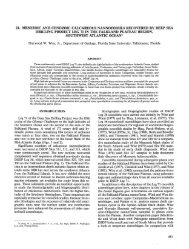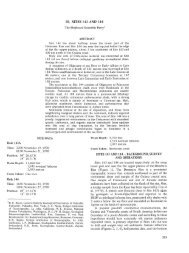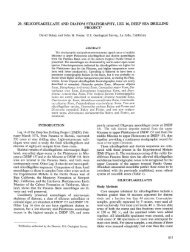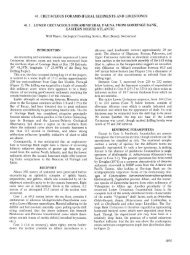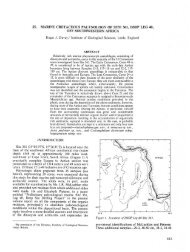16. Radiolaria - Deep Sea Drilling Project
16. Radiolaria - Deep Sea Drilling Project
16. Radiolaria - Deep Sea Drilling Project
You also want an ePaper? Increase the reach of your titles
YUMPU automatically turns print PDFs into web optimized ePapers that Google loves.
M. G. PETRUSHEVSKAYA, G. E. KOZLOVA<br />
Genus LIPMANELLA Loeblich and Tappan,<br />
emend. Petruskevskaya<br />
Lipmanella Loeblich and Tappan, 1961, p. 119. = Dictyoceras<br />
Haeckel, 1860, p. 333; 1887, p. 1324; Campbell, 1954, p. 130;<br />
Petrushevskaya, 1971b, pp. 198, 220. Type species Lithornithium<br />
dictyoceras Haeckel (Haeckel, 1862, pi. 8, figs. 1-5).<br />
The cephalis thick-walled, divided (as a rule) into upper and<br />
lower parts by means of the arches ap, as in Squinabollum and in<br />
Dicolocapsa. The thorax is larger than the cephalis. The abdomen<br />
may be separated distinctly from the thorax or it may be united<br />
with the thorax in a single segment. The spines D, LI and Lr form<br />
external feet, which are rather weak. They go laterally from the<br />
thorax. In the upper walls of the thorax are three ribs formed by<br />
these spines. The spine A forms the apical horn. The mouth of the<br />
shell is very often open.<br />
Cretaceous?-Quaternary.<br />
Remark: The taxonomical position of the genus is doubtful-maybe<br />
it is really pterocoryid.<br />
Lipmanella (?) sp. aff. Lithomelissa? amazon Foreman<br />
(Plate 37, Figure 1)<br />
^.Lithomelissa amazon Foreman, 1968, p. 26, pi. 4, fig. 1.<br />
The division of the cephalis into lower and upper parts is not<br />
developed. In typical Lithomelissa amazon, the cephalis is smoother.<br />
Paleogene.<br />
Lipmanella (?) sp. M<br />
(Plate 37, Figure 2)<br />
The thorax, the spines and the pores are very much the same as<br />
in Lipmanella (?) sp. aff. Lithomelissa amazon. The difference is in<br />
the smaller dimensions and in the cephalis being constricted at its<br />
base, with pronounced subdivision into upper and lower parts.<br />
Miocene.<br />
Lipmanella sp. O<br />
(Plate 37, Figures 4,5)<br />
Differs from Lipmanella (?) sp. M by the distinct subdivision of<br />
the skeleton into thorax and abdomen.<br />
This species is somewhat similar to Dictyoceras insectum<br />
Haeckel (1887, pi. 71, fig. 6), and there is no doubt in the generic<br />
identification of this species (Dictyoceras = Lipmanella). It is also<br />
somewhat similar to Pterocorys columbo Haeckel (1887, pi. 71, fig.<br />
2), but differs in the construction of the cephalis. Some specimens<br />
are similar to Pterocyrtidius barbadense (Ehrenberg) (see Plate 27,<br />
Figure 18, 19) in the proportions of the test.<br />
Miocene.<br />
Lipmanella (?) dogieli (Petrushevskaya)<br />
(Plate 37, Figure 10)<br />
Sethoconus (?) dogieli Petrushevskaya, 1967, p. 95, pi. 53, figs. 1,2;<br />
1971b, pi. 110, fig. 2.<br />
The number of pores is less than in Lipmanella sp. C-only about<br />
7 pores on a half equator. Pores are irregular and of different sizes.<br />
There is no subdivision into thorax and abdomen.<br />
Pliocene-Quaternary.<br />
Remark: This species is very similar also to the Miocene species<br />
described as Lithomelissa campanulaeformis by Campbell and<br />
Clark (1945, p. 44, pi. 6, fig. 1), see Plate 37, Figure 11 in the<br />
present report. Lipmanella (?) dogieli differs from L. campanulaeformis<br />
by smaller dimensions. Perhaps it represents by itself only<br />
Quaternary subgenus of the Miocene species L. campanulaeformis.<br />
Subfamily Group E<br />
To include genera without a wide velum (characteristic for<br />
Neosciadiocapsidae). In place of the velum there is a long, nearly<br />
cylindrical abdomen. Abdominal pores are much larger than<br />
thoracic pores, and therefore the thorax and abdomen seem to be<br />
built of different kinds of skeletal meshwork. Cephalis of the same<br />
kind as in Neosciadiocapsidae, with the arches ap going in the upper<br />
walls. Cephalis conical, wide at the base. The apex gradually turns<br />
into a conical apical horn. Lampterium is the most typical genus of<br />
the group. Whether this group should be placed among Pterocoryidae<br />
or among Neosciadiocapsidae is questionable.<br />
542<br />
Genus THYRSOCYRTIS Ehrenberg<br />
Thyrsocyrtis Ehrenberg, 1847b, p. 54; Haeckel, 1887, p. 1350;<br />
Campbell, 1954, p. 130; Riedel and Sanfilippo, 1970, p. 525.<br />
Type species Thyrsocyrtis rhizodon Ehrenberg, 1873 (1875, pi.<br />
12, fig. 1).<br />
Podocyrtarium Haeckel, 1887, p. 1337; Campbell, 1954, p. 130.<br />
Type species Podocyrtis tripodiscus Haeckel, (1887, pi. 72,<br />
fig. 4).<br />
Podocyrtonium Haeckel, 1887, p. 1347, Campbell, 1954, p. 130.<br />
Podocyrtis pedicellaria Haeckel (1887, pi. 72, fig. 8).<br />
Differs from Lampterium by distinct longitudinal rows of pores<br />
not only on the thorax, but also on the abdomen. Differs from<br />
Podocyrtis 1) by the abdomen being larger than the thorax, and<br />
2) by the difference in the size between thoracic and abdominal<br />
pores.<br />
Tertiary.<br />
Thyrsocyrtis rhizodon Ehrenberg<br />
Thyrsocyrtis rhizodon Ehrenberg, 1873, p. 262; 1875, pi. 12, fig. 1;<br />
Riedel and Sanfilippo, in press, pi. 3C, fig. 6.<br />
Eocene.<br />
Thyrsocyrtis tetracantha (Ehrenberg)<br />
Podocyrtis tetracantha Ehrenberg, 1873, p. 254; 1875, pi. 13, fig. 2.<br />
Thyrsocyrtis tetracantha (Ehrenberg) Riedel and Sanfilippo, 1970,<br />
p.527.<br />
Eocene.<br />
Thyrsocyrtis triacantha (Ehrenberg)<br />
(Plate 32, Figure 9; Plate 34, Figure 6)<br />
Podocyrtis triacantha Ehrenberg, 1873, p. 254; 1875, pi. 13, fig. 4.<br />
Thyrsocyrtis triacantha (Ehrenberg) Riedel and Sanfilippo, 1970, p.<br />
526, pi. 8, figs. 2, 3; Moore, pi. 4, fig. 2.<br />
Eo cene-Oligocene ?<br />
Thyrsocyrtis argulus (Ehrenberg)<br />
(Plate 32, Figure 8)<br />
Podocyrtis argulus Ehrenberg, 1873, p. 248; 1875, pi. 16, fig. 2.<br />
Thyrsocyrtis hirsuta hirsuta (Krasheninnikov) Riedel and Sanfilippo,<br />
1970, p. 7, figs. 8,9.<br />
Eocene.<br />
Thyrsocyrtis sp. E<br />
(Plate 32, Figure 11)<br />
IPodocyrtis pedicellaria Haeckel, 1887, p. 1347, pi. 72, fig. 8.<br />
Wodocyrtis sinuosa (?) in Riedel and Sanfilippo, 1970, p. 534, pi.<br />
11, figs. 3,4.<br />
Eocene.<br />
Podocyrtis (?) or Thyrsocyrtis (?) mitra (Ehrenberg)<br />
Podocyrtis mitra Ehrenberg, 1854, pi. 36, fig. B 20; 1873, p. 251;<br />
non Ehrenberg, 1875, pi. 15, fig. 4.<br />
Podocyrtis (Lampterium) mitra (Ehrenberg) Riedel and Sanfilippo,<br />
1970, p. 534, pi. 11, figs. 5, 6; Moore, in press, pi. 3, fig. 4.<br />
Eocene.<br />
Thyrsocyrtis ? bromia Ehrenberg<br />
Thyrsocyrtis bromia Ehrenberg, 1873, p. 260; 1875, pi. 12, fig. 2;<br />
Riedel and Sanfilippo, 1970, p. 526; Riedel and Sanfilippo, in<br />
press, pi. 8, fig. 6, Moore, in press, pi. 5, figs. 1-3.<br />
Cephalis and thorax very similar to Cyclamp terium species, but<br />
abdomen is smaller.<br />
Eocene.<br />
Genus LOPHOCYRTIS Haeckel<br />
Lophocyrtis Haeckel, 1887, p. 1410; Campbell, 1954, p. 134;<br />
Riedel and Sanfilippo, 1970, p. 529. Type species Eucyrtidium<br />
stephanophorum Ehrenberg (1873, p. 223; 1875, pi. 8,fig. 14).<br />
Differs from Thyrsocyrtis mainly by the abdomen being<br />
narrower.<br />
Lophocyrtis? jacchia (Ehrenberg) group<br />
(Plate 28, Figure 21)<br />
Thyrsocyrtis jacchia Ehrenberg, 1873, p. 261; 1875, pi. 12, fig. 7.<br />
Thyrsocyrtis dionisia Ehrenberg, 1873, p. 260; 1875, pi. 12, fig. 5.



